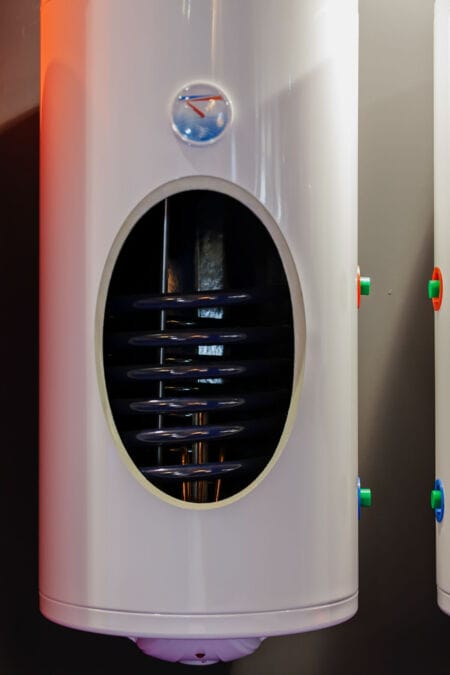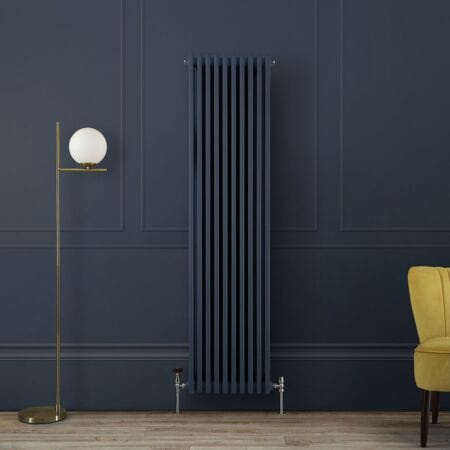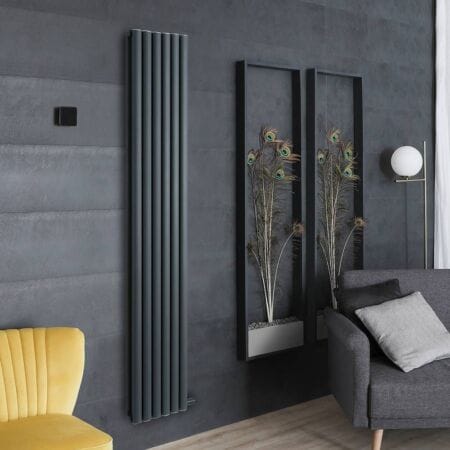Contents
ToggleWhat we'll cover...
Handy expert advice and step-by-step guidance for hanging a radiator in your home for an effective and good-looking installation.
Simple tips for radiator mounting
As fancy as many of our designer radiators may be, we can admit their inability to hang themselves. And while slapping one on the wall might seem a simple task on the face of it, there’s a bit more to it than lining up a few brackets and hoping for the best.
But can you install designer radiators yourself? Absolutely. There’s a few ways to best mount a radiator, and if you know what you’re doing properly, you can complete the job of hanging a radiator in as little as 20 minutes.
Whether you’re giving your space a style upgrade or repositioning radiators for better heat distribution, this guide will discuss everything you need to know about how to hang a radiator, the proper way.
We’re talking wall types, tool choices, bracket wizardry, and the all-important “is it level?” check.
Required tools and materials
Think of this as your radiator-hanging starter kit. Basically, a DIY essentials checklist to avoid a multitude of mid-job trips to the shed.
Tool checklist:
- Radiator (obviously)
- Radiator brackets (included with your radiator)
- Spirit level (non-negotiable)
- Tape measure
- Pencil
- Drill and correct wall bits (masonry or wood)
- Rawl plugs (wall anchors)
- Screws (appropriate for wall type)
- Stud detector (optional, but extremely helpful)
- Adjustable spanner
- Wall plugs and cavity fixings (especially for plasterboard walls)
- Vacuum or dustpan (trust us, you’ll need it)
Don’t take the cheap option for wall fixings, especially if you’re dealing with plasterboard or dot-and-dab. Radiators can weigh over 30kg, and gravity doesn’t care one jot about aesthetics.

Step 1: Consider radiator placement
Before you get bracket-happy, it’s time for a bit of strategic thinking. Radiator placement isn’t just about what fits where. It’s about:
- Optimising heat distribution
- Working with your plumbing layout
- Avoiding unnecessary disruption (and rearrangement of furniture)
Some useful questions to consider ahead of radiator placement are as follows…
- How close can a socket be to a radiator in the UK? – There are no defined regulations, but it is recommended to leave a gap of between 150 to 300mm, or 6 to 12 inches from a socket to a radiator.
- Should a radiator be placed above a skirting board? – Radiators can be positioned above a skirting board safely; it is recommended that the foot of a wall-mounted radiator is positioned a minimum of 100-150mm from the floor, but the presence of a skirting board may necessitate a greater distance for aesthetic reasons.
Height of radiator from the floor
The sweet spot for most radiators is somewhere between 100–150mm (4–6 inches) from the floor. This allows enough clearance for radiator valves, heating pipework, and a cheeky hoover run underneath, as and when required.
Vertical radiators need at least 50mm at the top as well to efficiently and effectively deliver heat around the room.
Consider your wall type
Your wall might look solid, but it would potentially be unwise to trust it at face value.
- Solid brick or concrete: Ideal. Just make sure you use masonry drill bits and wall plugs.
- Plasterboard: Proceed with caution. You’ll need to find studs or use specialist plasterboard fixings.
- Dot and dab: A mixture of block wall and adhesive dabs under plasterboard – best tackled with long frame fixings or grip-it plugs.
At this point, give the wall a few taps. A hollow thud = plasterboard, solid thud = masonry. You might sound slightly unhinged for a minute or two, but it works.
Step 2: Mark bracket positions
Now to get going.
Step-by-step:
- Measure the width and height of the radiator.
- Consult the bracket spacing in the instructions (they’re all different, so don’t just guess).
- Use a spirit level and pencil to mark where each bracket should go.
- Triple-check distances between pipe centres (if existing pipework is already in place).
- Measure again. Then once more. Nobody wants to have to re-drill.
If your radiator features bottom fixings (common with vertical designs), double-check the height for both form and function. You want them low enough to heat the room adequately, but not so low your skirting board blocks valve access.
This is the make-or-break moment. The difficult third album. Brackets are what will support your radiator crucially, so let’s make sure they’re fitted right.
If you’ve never drilled into a wall before, don’t panic. Begin with a small pilot bit, hold the drill straight, and let it do the work. If you hit something metallic or the drill suddenly kicks, stop immediately. It could be pipework, electrical cable, or the ghost of a DIYer past.
How to install:
- Drill pilot holes at the marked points.
- Insert the appropriate rawl plugs (check your wall type).
- Secure the radiator brackets using screws, checking for level again.
- Gently tighten the brackets into place. Not so loose that they wobble, not so tight that they distort.
Wall fixings - Cheat sheet
Wall Type | Fixing Type |
Brick/concrete | Standard wall plugs + screws |
Plasterboard | Grip-it plugs / spring toggles |
Dot and dab | Long frame fixings or cavity anchors |
Wooden stud | Direct fix with wood screws |
Step 4: Hanging the radiator
With brackets up, it’s time for the final step; the big lift. Ideally, this is a two-person job, especially if your radiator is large, heavy, or especially in the case of cast iron radiators (a.k.a. “the spine-busters”).
Protect your flooring with an old towel or radiator foot covers before lifting. Some radiators incorporate rough under-edges that can scratch tiles or wooden floors in a flash.
Steps to hang:
- Lift the radiator slowly and line it up with the wall brackets.
- Hook it over the top bracket clips.
- Gently lower into position so the bottom slots in neatly.
- Make sure it sits flush and doesn’t wobble. If it’s loose, double-check bracket placement or use retaining clips.
Which way do radiator brackets go?
It depends on the radiator, but generally;
- The shorter lip faces down
- The deeper hook goes at the top
Common mistakes to avoid
Even confident DIYers can fall foul of a few classic radiator-hanging traps:
- Hanging without checking wall strength
Plasterboard can’t handle 40kg of radiator with rawl plugs from the pound shop. Use proper cavity fixings from a trusted hardware shop. - Mounting too low or too high
You’ll restrict airflow, reduce efficiency, and make the valves a pain to access. Aim for a clearance space of at least 100mm from the floor, with 150mm or 6 inches recommended to provide optimal heat circulation and ease of installation. - Not using a spirit level
That 2° slope will be noticeable and gnaw away every time you look at it. Or worse, someone else in the house notices the error and repeatedly makes mention of it. Better to get it right the first time. - Incorrect bracket spacing
Leads to instability, rattling sounds, and in the worst cases, radiators deciding they’re floor décor. - Guessing pipework alignment
Don’t make assumptions. Thoroughly check valve centres and spacing before drilling anything.
Next steps after hanging your radiator
You’ve made it! Time to admire your handiwork, clean up the dust, and move onto the connection part.
Hanging your new radiator with BestHeating
Once your radiator is secure on the wall, follow our expert guide to attach it to your heating system.
From sleek verticals to traditional column radiators, BestHeating has you covered for radiators well worth showing off, and all the advice you need to hang them like a pro.
Explore our heating advice centre for further guides and information, and let us know about your new radiator hanging projects in the comments, or through Instagram, Facebook or X.
John is a Research Specialist for the Best Heating Advice Centre, where for over nine years he has dedicated himself to demystifying home heating for our customers. He specialises in creating clear, data-driven guides and how-to articles by collaborating directly with our team of certified heating experts and product engineers.
His work, built on a foundation of journalistic research, has helped millions of readers make confident and informed decisions about their home heating. When he’s not breaking down the heat output differentials from radiators to heated towel rails, John fancies himself as a fine football and music connoisseur.








